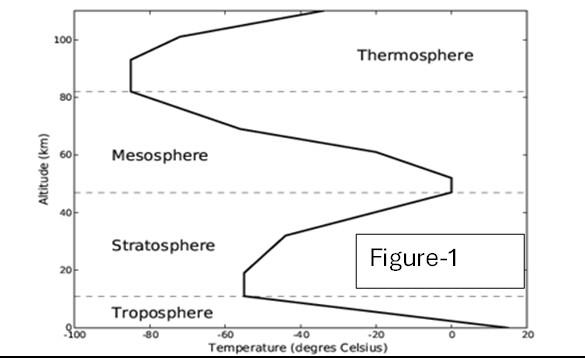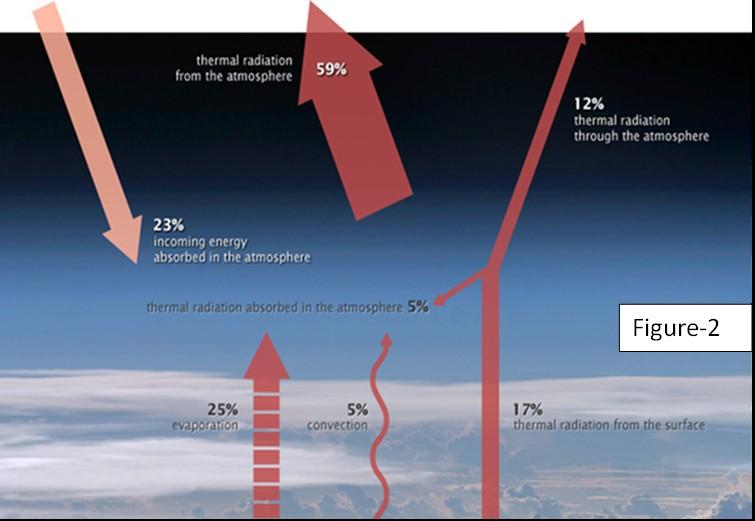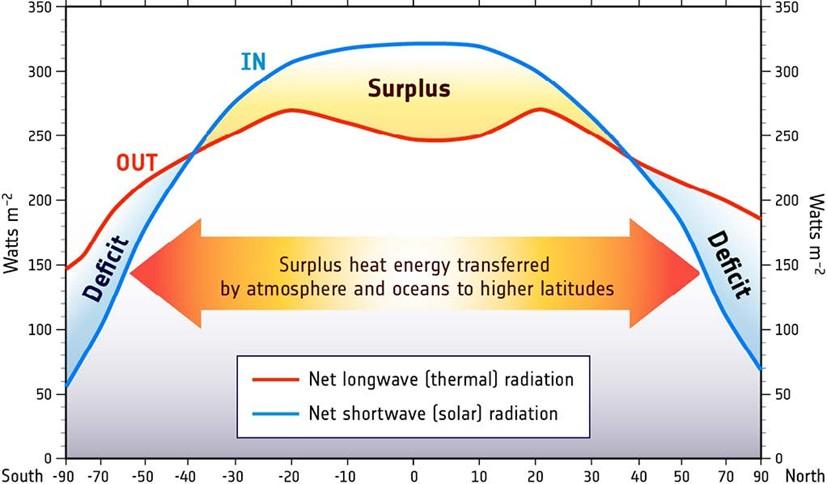Please see link above for source text.
Why we must challenge the NASA Earth Energy Budget?
Part I Water Vapor.
February 24, 2024, Terigi Ciccone

Abstract.
The UN Intergovernmental Panel on Climate Change (UN-PCC), NASA, NOAA, and their climate scientists worldwide, collectively called “UN IPCC,” have an unresolved problem. Based on known methods and instruments, the surface of the Earth is approximately 32 degrees Celsius warmer than can be explained by the solar energy arriving on Earth. However, the UN IPCC has reached a consensus that CO2, water vapor, and other Radiatively Active Gases “CO2/RAGs” that they call “Greenhouse Gases” combined with the “Greenhouse Effect” explains all of this extra 32 C temperature increase of the last 170 years. As used in this discussion, all Greenhouse Gases will be collectively referred to as “RAGS” unless noted otherwise. The RAGS include water vapor at 95% of the RAGS, CO2 at 3.6%, methane, and all the others at 1.4%.
Furthermore, there has been an increase in the global average temperature of about 1.2 C since 1850 and an increase in atmospheric CO2 from about 0.028% to about 0.042% of the atmosphere. The UN IPCC concludes that the increased RAGS is caused by humans burning fossil fuels and human-made fertilizers, which are the sole causes of this increased temperature. These first and subsequent articles argue that the UN IPCC conclusion is neither supported by test data nor explained by established laws of physics, chemistry, thermodynamics, or historical data.
Discussion on the role of water vapor.
Water vapor’s role in the atmosphere is complex, not well-understood by scientists, and not at all by laypeople. We start with some relevant background information about water vapor. Water vapor is a gas like oxygen and CO2, and the percentage of water vapor in the air varies based on temperature. The percent of water vapor in the cold Arctic, Antarctic, and the highest Alpine regions may reach as low as 0.2% of the air, while in the warmest tropical air, it may contain up to 5%. So, in the lower altitudes in the tropics, water vapor is the third most plentiful atmospheric gas after nitrogen and oxygen. Even in the cold polar/alpine areas, it is about five times more abundant than CO2 for the first several kilometers of altitude. However, water vapor starts to freeze at elevations above a few kilometers and ceases to function as a gas. Meanwhile, CO2 remains a gas at almost -80 C, near the top of the mesosphere.

Now let's look at Figure-2 to see what the UN IPCC said about it in their Earth Energy Budget (EEB) back in 2009, when NASA-NOAA maintained a greater integrity level, and see what they said about water vapor. We start by taking an overview of the 2009 NASA EEB and doing some simple arithmetic. You can read the complete NASA article at Climate and Earth’s Energy Budget.
The first thing we see in Figure-2 is that 59% of the solar radiation that arrives on Earth escapes back to space by radiation through the atmospheric gases, and 12% escapes directly from the surface of the Earth as radiation that does not interact with the air and goes through the “Atmospheric Window.” If we use an albedo of about 30%, we have already accounted for all the net solar energy arriving on Earth, about 70-71%. Albedo is the amount of solar energy reflected into space. Where does this 59% come from? In Figure-2, NASA tells us that 23% comes directly from the sun, warming the air. 25% comes from the water on the surface, changing the state from a liquid into gaseous water vapor and warming the air. This warmed air rises, is dispersed/circulated by winds, and warms the atmosphere to the top of the troposphere (10 kilometers up). Then 5% comes from the thermals/convection of air rising from the surface, as we see when smoke rises. Lastly, 5% of radiant warming comes up from the surface into the atmosphere and warming it. The 12% is derived
from (17% from the surface, less 5%) to warm the air. We checked our arithmetic (23 + 25+ 5 + 5) = 59%, and it’s about right.
So immediately note that, as the surface cools, it warms the atmosphere more than the sun does: 35% from the surface (25% evaporation + 5% convection + 5% radiation) versus only 23% from the sun. But now we get into the bonus area in three consequential ways.

- First, the water vapor in the air slowly cools, and over days to weeks, turns from a gas back into liquid water droplets and ice crystals and forms clouds. During this condensation process, water vapor directly releases the 25% latent heat while transforming it into radiation that will exit into space and bypass all the RAGs like CO2. So, water vapor has effectively trapped and held the 25% evaporation heat in the troposphere, slowly releasing it into space, thus keeping the earth’s lower atmosphere’s temperature warm for days or weeks. Perhaps some portion of the 5% convection heat may also be involved. As Richard Lindzen says, atmospheric science involves many complex forces and cycles, especially clouds, which scientists do not understand well: data source, https://www.climatedepot.com/2023/11/26/watch-mit-climate-scientistdr-richard-lindzen-suggests-sadism-driving-climate-policies-allged-solutions-havehad-no-impact-on-co2-but-they-make-people-poorer-make-society-less-stable/.
This atmospheric warming and delayed cooling of the water vapor evaporation/condensation cycle is a more reasonable explanation, in part or in whole,
for the missing 32 C than the UN IPCC attributes to the CO2/RAGs and the greenhouse effect.
- Second, During the night hours, the sun stops heating the earth, but the earth continues to cool by 5% convection! The clouds formed by water vapor stop the convection flow and further slow down the cooling process of the lower troposphere. So effectively, the clouds, combined with the above latent heat, now act as a thermal blanket, trapping-holding the heat near the surface and the lower atmosphere and preventing it from escaping to space too fast. You would notice this effect if you spent a night in a high-altitude desert without clouds and saw how quick and cold the night gets.

-Third, the clouds formed by water vapor perform many substantive roles in moderating the earth’s temperature. This occurs in the troposphere, where it matters the most because that’s where all life exists. We look at Figure-3 and see on the left that from the incoming solar energy, 30% is immediately reflected into space, thus cooling the Earth. We also see that clouds account for 20% of what is radiated into space by clouds. Then, on the right side, we see that clouds also radiate 20% of the surface radiation into space. So, clouds effectively send 37% of the total incoming solar energy reflected and radiated to space while holding the heat in the clouds. This appears to add additional credibility to the concept of the water vapor warming blanket discussed in the First point above. Figure-3 and the explanation is from the article found by the search engine EDGE, but not by Google.
EDGEhttps://bio.libretexts.org/Courses/Gettysburg_College/01:_Ecology_for_All/ 02:_The_Physical_Environment/2.05:_Earth%27s_Energy_Balance.
Why are these three points important? Because the UN IPCC has a problem that can’t be easily explained or dismissed. So, let’s look at Figure-3A below, another of the many versions of NASA’s EEBs, to help us understand their dilemma, source https://mynasadata.larc.nasa.gov/basic-page/earths-energy-budget. The first difference we notice is the addition of the big up and down red arrows enclosed within the hand-drawn red collective. The numbers shown in Figure-3A are expressed as energy measured in watts per square meter (W). Figure-2 expresses them as partial percentages of the 100% incoming solar energy. Otherwise, they are identical except for the values inside the red collective. For example, in Figure-2, 23% of the solar energy is warming the atmosphere. In Figure-3A, 77.1 watts (W) are warming the atmosphere, basically the same as 22.9%.
Below is a quick reference table where we see similarities and confusing differences in items 5 and 6 inside the red collective, which are the heart of the CO2 global warming debates.
Item Figure-3A Figure-2
1-Solar
8-Net

It can be seen from Figure-3A that a net of 239.9 W is arriving from the sun by taking the 340.4 W and subtracting the reflected albedo of (77 W and 22.9 W) and the 0.6 W that is stored in the earth’s biosystem. We then see that a total of 239.9 exits from the earth by radiation, adding 169.9 from the atmosphere, 29.9 from the clouds, and 40.1 from the Atmospheric Window. The incoming and outgoing radiation systems appear balanced at 239.9 W. However, the fundamental problem faced by NASA in Figure-3A and the above table items 5 and 6 is that the Earth’s surface emits more radiant energy (398.2) than it receives from the sun or the atmosphere. These three measurements are made with the same technology and include the Stephan-Boltzmann Equation, which converts energy measured in W to temperature measured in C. Now, the incoming energy from the sun and outgoing energy from the earth are measured outside the earth’s environment, in the vacuum, temperature, and space conditions. By contrast, 398.2 W is a number fabricated on several assumptions, requiring the Earth to be a blackbody emitter in thermal stability and with a solid radiating surface.
1. UN IPCC treats the earth as a blackbody absorber/emitter and is in thermal stability, but that is not the case. First, the earth is never in thermal stability. As seen in Figure-3B, the earth can never be in thermal balance because of the imbalance between heat gain and heat loss as a function of the solar warming cycle and latitudes. The sun only warms a small portion of the earth for about 6 hours daily. Then, excess heat received near the equator and daytime vs. nighttime and polar regions variations are poorly and inefficiently transferred toward the poles by complex air and ocean circulation patterns. See source document and Fig 2.5.8 . https://bio.libretexts.org/Courses/Gettysburg_College/01:_Ecology_for_All/ 02:_The_Physical_Environment/2.05:_Earth%27s_Energy_Balance.
However, NASA treats the earth like a flat pancake with an average temperature of around 15 C. So, there's no day or night on flat earth, and that 15 C temperature is warming the poles as much as the equator. And there are no mountains or valleys, thus no circulation patterns. So, the top of Mt Everest radiates at 15 C, just like the Sahara and the polar oceans.

Figure3B
2. NASA boldly asserts that Earth has no other heat warming the surface other than the sun. They ignored animal respiration, bio-fermentation, geologic heating, El Nino/La Nina, or volcanic eruption warming and cooling effects.
3. NASA also pretends that the earth has a flat and solid radiating surface like a blackbody, but it’s actually “constructed” about six feet above the waters and lands. They pretend this acts as a solid radiative surface that would want to send 100% of the radiation to space. However, the CO2/RAG molecules radiate in a 360 degrees in random direction, with about 50% going up and 50% going down, after adjusting for scattering, reflections, photon absorptions, and re-emissions. The UN IPCC makes many assumptions, adjustments, and estimations that turn 398.2 W of emitted radiation into a “back radiation” of 340.3 W. How good are these estimates and approximations that can’t even be explained by the existing laws of physics, chemistry, or thermodynamics, or by experimental data?
In Summary, the UN IPCC attempts to homogenize and adjust these complex and unknown variables by giggling with an average global albedo, the false science/mathematics of the Radiative Transfer Equations, and their computer models. But remember that the Stephan-Bolzman equation calculates Radiated energy to the fourth power of Temperature. So, an error of just 2W per square meter multiplies the temperature error to the fourth power or 16 times.
Conclusion.
The UN IPCC and subservient political organizations and their servile universities and scientists chose to follow the political-economic path and not the scientific method. The scientific method would have required scientists to say we don’t know what causes climate change. We don’t have enough information to resolve the many questions and admit that the science of climate change is not well understood. Therefore, we must study more related fields like physics, chemistry, geology, astronomy, thermodynamics, etc., to determine the root causes of climate change and their proportional contributions and interactions.

However, this would have undercut the UN IPCC and its political and economic ambitions. The UN IPCC is only chartered to investigate causes of climate change that are either caused by or can be mitigated by human activities. Without human contributions or mitigations, thousands of U.N. bureaucrats, NASA, Michael Mann, and their paid servile scientists in hundreds of universities worldwide would be out of their cushy, well-paying, high-profile jobs. Over the years, the UN IPCC and other parties concocted the elaborate concept that humans cause global warming by burning fossil fuels and using synthetic fertilizers that increase atmospheric CO2/methane and the greenhouse effect as the only cause of climate change-global warming.
Figure-4 is their solution. However, if the scientific method had been selected, $trillions would have been saved, the health and lives of billions of people would have been improved, and millions would be free from the fears and anxiety of the fabricated runaway global warming hysteria.
In Part II, we address How the sun warms the Earth and how the Earth cools.
Additional sources and references:
Atmospheric Water Turnover , The Primary Driver of Global Warming, By Walter Fiori, 5 April, 2021 (99+) Atmospheric Water Turnover -The Primary Driver of GW | Walter Fiori - Academia.edu
Water Vapor Rules the Greenhouse System¸by Dr. S. Fred Singer, https://climatecite.com/water-vapor-rules-the-greenhouse-system/#:~:text=Water %20vapor%2C%20responsible%20for%2095,This%20is%20insignificant!
How to Think about Climate Change. By William Happer, How to Think about Climate Change: The Independent Institute
What causes global warming? Low Cloud Cover is the key from recent NASA, Finish and Japanese studies.
https://www.academia.edu/39359172/What_causes_global_warming_Low_Cloud_C over_is_the_key_from_recent_NASA_Finish_and_Japanese_studies_New_evidence _suggests_that_high_energy_particles_from_space_known_as_galactic_cosmic_ray s_affect_the_Earth_s_climate_by_increasing_cloud_cover_causing_an_umbrella_ef fect_
